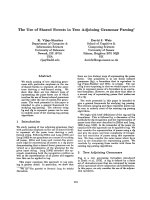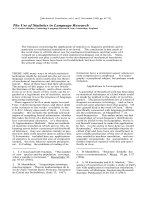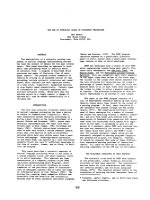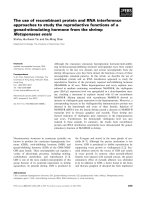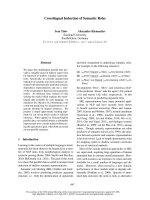Báo cáo khoa học: "The use of formal language models in the typology of the morphology of Amerindian languages" potx
Bạn đang xem bản rút gọn của tài liệu. Xem và tải ngay bản đầy đủ của tài liệu tại đây (98.55 KB, 6 trang )
Proceedings of the ACL 2010 Student Research Workshop, pages 109–114,
Uppsala, Sweden, 13 July 2010.
c
2010 Association for Computational Linguistics
The use of formal language models in the typology of the morphology of
Amerindian languages
Andr
´
es Osvaldo Porta
Universidad de Buenos Aires
Abstract
The aim of this work is to present some
preliminary results of an investigation in
course on the typology of the morphol-
ogy of the native South American lan-
guages from the point of view of the for-
mal language theory. With this object,
we give two contrasting examples of de-
scriptions of two Aboriginal languages fi-
nite verb forms morphology: Argentinean
Quechua (quichua santiague˜no) and Toba.
The description of the morphology of the
finite verb forms of Argentinean quechua,
uses finite automata and finite transducers.
In this case the construction is straight-
forward using two level morphology and
then, describes in a very natural way the
Argentinean Quechua morphology using
a regular language. On the contrary, the
Tobaverbs morphology, with a system that
simultaneously uses prefixes and suffixes,
has not a natural description as regular lan-
guage. Toba has a complex system of
causative suffixes, whose successive ap-
plications determinate the use of prefixes
belonging different person marking pre-
fix sets. We adopt the solution of Crei-
der et al. (1995) to naturally deal with this
and other similar morphological processes
which involve interactions between pre-
fixes and suffixes and then we describe the
toba morphology using linear context-free
languages.
1
.
1 Introduction
It has been proved (Johnson, 1972; Kaplan and
Kay, 1994) that regular models have an expre-
1
This work is part of the undergraduate thesis Finite
state morphology: The Koskenniemi’s two level morphology
model and its application to describing the morphosyntaxis
of two native Argentinean languages
sive power equal to the noncyclic components
of generative grammmars representing the mor-
phophonology of natural languages. However,
these works make no considerations about what
class of formal languages is the natural for de-
scribing the morphology of one particular lan-
guage. On the other hand, the criteria of classi-
fication of Amerindian languages, do not involve
complexity criteria. In order to establish crite-
ria that take into account the complexity of the
description we present two contrasting examples
in two Argentinean native languages: toba and
quichua santiague˜no. While the quichua has a nat-
ural representation in terms of a regular language
using two level morphology, we will show that the
Toba morphology has a more natural representa-
tion in terms of linear context-free languages.
2 Quichua Santiague
˜
no
The quichua santiague˜no is a language of the
Quechua language family. It is spoken in the San-
tiago del Estero state, Argentina. Typologically
is an agglutinative language and its structure is al-
most exclusively based on the use of suffixes and is
extremely regular. The morphology takes a domi-
nant part in this language with a rich set of valida-
tion suffixes. The quichua santiague˜no has a much
simpler phonologic system that other languages of
this family: for example it has no series of aspi-
rated or glottalized stops.
Since the description of the verbal morphology
is rich enough for our aim to expose the regular na-
ture of quichua santiague˜no morphology, we have
restricted our study to the morphology of finite
verbs forms. We use the two level morphology
paradigm to express with finite regular transduc-
ers the rules that clearly illustrate how naturally
this language phonology is regular. The construc-
tion uses the descriptive works of Alderetes (2001)
and Nardi (Albarrac´ın et. al, 2002)
109
2.1 Phonological two level rules for the
quichua santiague
˜
no
In this section we present the alphabet of the
quichua santiague˜no with which we have imple-
mented the quichua phonological rules in the par-
adigm of two level morphology. The subsets
abbreviations are: V (vowel), Vlng (underlying
vowel).Valt (high vowel),VMed (median vowel),
Vbaj (bass vowel) , Ftr (trasparent to medializa-
tion phonema), Cpos (posterior consonant).
ALPHABET
aeiouptchkqsshllm
n lrwybdgggfhxrrr
AEIOUWNQY+’
NULL 0
ANY @
BOUNDARY #
SUBSET C p t chkqsshllm
n lrwybdfh
xrrrhQ
SUBSET V ieaouAEIOU
SUBSET Vlng IEAOU
SUBSET Valt uiUI
SUBSET VMed eoEO
SUBSET Vbaj a A
SUBSET Ftr nyrYN
SUBSET Cpos gg q Q
With the aim of showing the simplicity of the
phonologic rules we transcribe the two-level rules
we have implemeted with the transducers in the
thesis. R1-R4 model the medialization vowels
procesess, R5-R7 are elision and ephentesis proce-
sess with very specific contexts and R7 represents
a diachornic phonological process with a subja-
cent form present in others quechua dialects.
Rules
R1 i:i /<= CPos:@ __
R2 i:i /<= __ Ftr:@ CPos:@
R3 u:u /<= CPos:@ __
R4 u:u /<= __ Ftr:@ CPos:@
R5 W:w <=> a:a a:a +:0__a:a +:0
R6 U:0 <=> m:m __+:0 p:p u:u +:0
R7 N:0 <=> ___+:0 r:@ Q:@ a:a +:0
2.2 Quichua Santigue
˜
no morphology
The grammar that models the agglutination order
is showed with a non deterministic finite automata.
This implemented automata is presented in Fig-
ure 1. This description of the morphophonology
was implemented using PC-KIMMO (Antworth,
1990)
3 The Toba morphology
The Toba language belongs, with the languages
pilaga, mocovi and kaduveo, to the guaycuru
language family (Messineo, 2003; Klein, 1978).
The toba is spoken in the Gran Chaco region
(which is comprised between Argentina, Bolivia
and Paraguay) and in some reduced settlements
near Buenos Aires, Argentina. From the point of
view of the morphologic typology it presents char-
acteristics of a polysynthetic agglutinative lan-
guage. In this language the verb is the morpho-
logically more complex wordclass. The grammat-
ical category of person is prefixed to the verbal
theme. There are suffixes to indicate plurals and
other grammatical categories as aspect, location-
direction, reflexive and reciprocal and desidera-
tive mode. The verb has no mark of time. As an
example of a typical verb we can considerate the
sanadatema:
Example 1 .
s- anat(a) -d -em -a
1Act- advice 2 dat ben
” Iadviceyou”
2
One of the characteristics of the toba verb mor-
phology is a system of markation active-inactive
on the verbal prefixes (Messineo, 2003; Klein,
1978). There are in this language two sets or ver-
bal prefixes that mark action:
1. Class I (In):codifies inactive participants, ob-
jects of transitive verbs and pacients of in-
transitive verbs. .
2. Class II(Act): codifies active participants,
subjects of transitive and intransitive verbs.
2
abrev: Act:active, ben:benefactive, dat:dative,inst: intru-
mental,Med: Median voice, pos: Posessor, refl: reflexive
110
q
0
q
1
q
2
q
3
q
4
q
5
q
6
q
7
q
8
q
9
q
10
q
11
q
15
q
16
q
17
q
18
q
20
q
21
Caus
λ
ModI
λ
Tr3
λ
|Refl
λ
Tr2
λ
Tr1
λ
Actor
λ
PlO2
Fut
Fut
Fut
O2
ModII
λ
ModIIO
λ
ModII
λ
Pas
λ
Pas
λ
Pas
λ
Ag23
Ag13
Ag123
Cond Gen
Top
Figure 1: Schema of the verbal morphology of the quichua santiague˜no. The supra indices λ indicate possible null transitions.
Abrev.: Caus: Causative suffixes.ModI: Set I of Modal Suffixes.Tri : i th. person trasition Suffixes.ModII: Set II of modal suffixes .Pas: Past suffixes. Ag:
AgentSuffix , in this case, for example, Ag1, indicates the agent suffix for the 1st person. Ag12 is an abbreviator for A1 ∪ A2. Cond : Conditional Suffixes. Gen
: General Suffixes. Fut: future suffixes.Top : Topicaliser suffixes. O2: Object 2nd person Suffixes. PLO2: Plural of Object 2nd person Suffixes.
111
Active affected(Medium voice, Med): codi-
fies the presence of an active participant af-
fected by the action that the verb codifies. .
The toba has a great quantity of morphological
processes that involve interactions between suf-
fixes and prefixes. In the next example the suffix-
ation of the reflexive (−l
at) forces the use of the
active person with prefixes of the voice medium
class because the agent is affected by the action.
Example 2 .
(a) y- alawat
3Activa -kill
” He kills”
(b) n- alawat -l’at
3Med- kill -refl
” He kills himself”
The agglutination of this suffix occurs in the
last suffix box (after locatives, directional and
other derivational suffixes). Then, if we model
this process using finite automata we will add
many items to the lexicon (Sproat, 1992). The
derivation of names from verbs is very productive.
There are many nominalizer suffixes. The result-
ing names use obligatory possessing person nom-
inal prefixes.
Example 3 .
l- edaGan -at
3pos write instr
”his pencil”
The toba language also presents a complex sys-
tem of causative suffixes that act as switching the
transitivity of the verb. Transitivity is specially ap-
preciable in the switching of the 3rd person prefix
mark. In section 3.2 we will use this process to
show how linear context free grammars are a better
than regular grammars for modeling agglutination
in this language, but first we will present the for-
mer class of languages and its acceptor automata.
3.1 Linear context free languages and
two-taped nondeterministic finite-state
automata
A linear context-free language is a language gen-
erated by a grammar context-free grammars G in
which every production has one of the three forms
(Creider et al., 1995):
1. A → a, with a terminal symbol
2. A → aB, with B a non terminal symbol and
a a terminal symbol.
3. A → Ba, with B a non terminal symbol and
a a terminal symbol.
Linear context-free grammars have been stud-
ied by Rosenberg (1967) who showed that there
is an equivalence between them and two-taped
nondeterministic finite-state automata. Informally,
a two-head nondeterministic finite-state automata
could be thought as a generalization of a usual
nondeterministic finite-state automata which has
two read heads that independently reads in two dif-
ferent tapes, and at each transition only one tape
moves. When both tapes have been processed, if
the automata is at a final state, the parsing is suc-
cessful. In the ambit that we are studying we can
think that if a word is a string of prefixes, a stem
and suffixes, one automata head will read will the
prefixes and the other the suffixes. Taking into
account that linear grammars are in Rosenberg’s
terms: ” The lowest class of nonregular context-
free grammars”, Creider et al. (1995) have taken
this formal language class as the optimal to model
morphological processes that involve interaction
between prefixes and suffixes.
3.2 Analysis of the third person verbal
paradigm
In this section we model the morphology of the
third person of transitive verbs using two-taped fi-
nite nondeterministics automata. The modeling of
this person is enough to show this description ad-
vantages with respect to others in terms of regular
languages. The transitivity of the verb plays an im-
portant role in the selection of the person marker
Class. The person markers are (Messineo, 2003):
1. i-/y- for transitive verbs y and some intra-
sitive subjects (Pr AcT).
2. d(Vowel) for verbs typically intransitives (Pr
ActI).
3. n: subjets of medium voice (Pr ActM).
The successive application of the causative
seems to act here, as was interpreted by Buckwal-
ter (2001), like making the switch in the original
verb transitivity as is shown en Example 4 in the
next page.
112
Example 4 .
IV de- que’e
he eats
TV i- qui’ -aGan
he eats(something)
IV de- qui’ -aGanataGan
he feeds
TV i- qui’ -aGanataGanaGan
he feeds(a person)
IV de qui’ -aGanaGanataGan
he command to feed
If we want to model this morphological process
using finite automata again we must enlarge the
lexicon size. The resulting grammar, althought
capable of modeling the morphology of the toba,
would not work effectively. The effectiveness
of a grammar is a measure of their productivity
(Heintz, 1991). Taking into account the productiv-
ity of causative and reflexive verbal derivation we
will prefer a description in terms of a context-free
linear grammar with high effectivity than another
using regular languages with low effectivity.
To model the behavior of causative agglutina-
tion and the interaction with person prefixes us-
ing the two-head automata, we define two paths
determined by the parity of the causative suffixes
wich have been agglutinated to the verb. We have
also to take into consideration the optative pos-
terior aglutination of reflexive and reciprocal suf-
fixes wich forces the use of medium voice person
prefix. From the third person is also formed the
third person indefinite actor from a prefix, qa -,
which is at left and adjacent to the usual mark of
the third person and after the mark of negation sa-
. Therefore, their agglutination is reserved to the
last transitions. The resulting two-typed automata
showed in Figure 2 also takes into account the rel-
ative order of the boxes and so the mutual restric-
tions between them (Klein, 1978).
4 Future Research
It is interesting to note that phonological rules in
toba can be naturally expressed by regular Finite
Transducers. There are, however, many South
American native languages that presents morpho-
logical processes analogous to the Toba and some
can present phonological processes that will have
a more natural expression using Linear Finite
Transducers. For example the Guarani language
presents nasal harmony which expands from the
root to both suffixes and prefixes (Krivoshein,
1994). This kind of characterization can have
some value in language classification and the mod-
eling of the great diversity of South American lan-
guages morphology can allow to obtain a formal
concept of natural description of a language.
.
References
Lelia Albarrac´ın, Mario Tebes y Jorge Alderetes(eds.)
2002. Introducci
´
on al quichua santiague
˜
no por
Ricardo L.J. Nardi. Editorial DUNKEN: Buenos
Aires, Argentina.
Jorge Ricardo Alderetes 2002. El quichua de Santiago
del Estero. Gram
´
atica y vocabulario Tucum´an:
Facultad de Filosof´ıa y Letras, UNT:Buenos Aires,
Argentina.
Evan L. Antworth 1990. PC-KIMMO: a two-level
processor for morphological analysis.No. 16 in Oc-
casional publications in academic computing. No.
16 in Occasional publications in academic comput-
ing. Dallas: Summer Institute of Linguistics.
Alberto Buckwalter 2001. Vocabulario toba. Formosa
/ Indiana, Equipo Menonita.
Chet Creider, Jorge Hankamer, and Derick Wood.
1995. Preset two-head automata and morphological
analysis of natural language . International Journal
of Computer Mathematics, Volume 58, Issue 1, pp.
1-18.
Joos Heintz y Claus Sch¨onig 1991. Turcic Morphol-
ogy as Regular Language. Central Asiatic Journal,
1-2, pp 96-122.
C. Douglas Johnson 1972. Formal Aspects of Phono-
logical Description. The Hague:Mouton.
Ronald M. Kaplan and Martin Kay. 1994. Regular
models of phonological rule systems . Computa-
tional Linguistics,20(3):331-378.
Harriet Manelis Klein 1978. Una gram
´
atica de la
lengua toba: morfolog
´
ıa verbal y nominal. Univer-
sidad de la Rep´ublica, Montevideo, Uruguay.
Natalia Krivoshein de Canese 1994. Gram
´
atica de
la lengua guaran
´
ı. Colecci´on Nemity, Asunci´on,
Paraguay.
Mar´ıa Cristina Messineo 2003. Lengua toba (guay-
cur
´
u). Aspectos gramaticales y discursivos. LIN-
COM Studies in Native American Linguistics 48.
M¨unchen: LINCOM EUROPA Academic Publisher.
A.L Rosenberg 1967 A Machine Realization of the
linear Context-Free Languages. Information and
Control,10: 177-188.
Richard Sproat 1992. Morphology and Computation.
The MIT Press.
113
q
0
q
1
q
2
q
3
q
4
q
5
q
6
q
7
q
8
q
9
q
10
q
11
q
13
q
14
q
15
q
16
q
17
q
18
Caus
Caus Caus Caus Caus Pl Act
Caus
Caus
Pl Act
Pl Act
Pl Act
Dir
Asp
Dir Loc
Pl Act
Asp
Dir Loc
Pl Act
Pl Act
Pl Act
Asp
Asp
Dir
Asp
Asp
Dir
Recp/Refl
Recp/Refl
Pr AcI
Pr AcI
Pr AcT
qa−
Pr AcM
Pr AcT
Pr AcI
Neg
Figure 2: Schema of the 3rd person intransitive verb morphology of the toba .
The entire and dotted lines indicating transitions of the sufix and preffix tape, respectively
Abrev: Caus: Causative suffix. Pl Act: plural actors suffix. Asp: aspectual suffix. Dir: directive suffix. Loc: locative suffix. Recp: reciprocal action suffix. Refl:
reflexive suffix. Pr.Ac: acting person prefix(T: transitive, I: intransitive, M: medium) qa-: indeterminate person prefix. Neg: negation prefix
114

